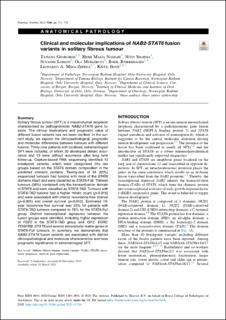| dc.contributor.author | Georgiesh, Tatiana | |
| dc.contributor.author | Namløs, Heidi Maria | |
| dc.contributor.author | Sharma, Nitin | |
| dc.contributor.author | Lorenz, Susanne | |
| dc.contributor.author | Myklebost, Ola | |
| dc.contributor.author | Bjerkehagen, Bodil | |
| dc.contributor.author | Meza-Zepeda, Leonardo A. | |
| dc.contributor.author | Boye, Kjetil | |
| dc.date.accessioned | 2022-04-01T13:24:10Z | |
| dc.date.available | 2022-04-01T13:24:10Z | |
| dc.date.created | 2021-07-19T20:23:18Z | |
| dc.date.issued | 2021 | |
| dc.identifier.issn | 0031-3025 | |
| dc.identifier.uri | https://hdl.handle.net/11250/2989340 | |
| dc.description.abstract | Solitary fibrous tumour (SFT) is a mesenchymal neoplasm characterised by pathognomonic NAB2-STAT6 gene fusions. The clinical implications and prognostic value of different fusion variants has not been clarified. In the current study, we explore the clinicopathological, prognostic and molecular differences between tumours with different fusions. Thirty-nine patients with localised, extrameningeal SFT were included, of whom 20 developed distant recurrence and 19 were without recurrence after long term follow-up. Capture-based RNA sequencing identified 12 breakpoint variants, which were categorised into two groups based on the STAT6 domain composition in the predicted chimeric proteins. Twenty-one of 34 (62%) sequenced tumours had fusions with most of the STAT6 domains intact and were classified as STAT6-Full. Thirteen tumours (38%) contained only the transactivation domain of STAT6 and were classified as STAT6-TAD. Tumours with STAT6-TAD fusions had a higher mitotic count (p=0.016) and were associated with inferior recurrence-free interval (p=0.004) and overall survival (p=0.012). Estimated 10-year recurrence-free survival was 25% for patients with STAT6-TAD tumours compared to 78% for the STAT6-Full group. Distinct transcriptional signatures between the fusion groups were identified, including higher expression of FGF2 in the STAT6-TAD group and IGF2, EGR2, PDGFRB, STAT6 and several extracellular matrix genes in STAT6-Full tumours. In summary, we demonstrate that NAB2-STAT6 fusion variants are associated with distinct clinicopathological and molecular characteristics and have prognostic significance in extrameningeal SFT. | en_US |
| dc.language.iso | eng | en_US |
| dc.publisher | Elsevier | en_US |
| dc.rights | Navngivelse 4.0 Internasjonal | * |
| dc.rights.uri | http://creativecommons.org/licenses/by/4.0/deed.no | * |
| dc.title | Clinical and molecular implications of NAB2-STAT6 fusion variants in solitary fibrous tumour | en_US |
| dc.type | Journal article | en_US |
| dc.type | Peer reviewed | en_US |
| dc.description.version | publishedVersion | en_US |
| dc.rights.holder | Copyright 2021 the authors | en_US |
| cristin.ispublished | true | |
| cristin.fulltext | original | |
| cristin.qualitycode | 1 | |
| dc.identifier.doi | 10.1016/j.pathol.2020.11.010 | |
| dc.identifier.cristin | 1922135 | |
| dc.source.journal | Pathology | en_US |
| dc.source.pagenumber | 713-719 | en_US |
| dc.identifier.citation | Pathology. 2021, 53 (6), 713-719. | en_US |
| dc.source.volume | 53 | en_US |
| dc.source.issue | 6 | en_US |

